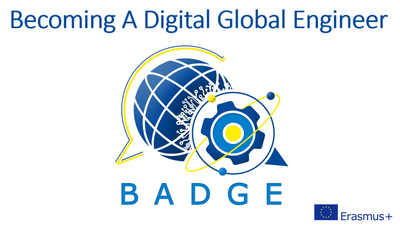BADGE – Becoming a Digital Global Engineer

Intellectual Output
BADGE – Becoming a Digital Global Engineer
Project 2019-1-FR01-KA203-063010 (167 512 512)

BADGE – Becoming a Digital Global Engineer
Project 2019-1-FR01-KA203-063010 (167 512 512)
After studying this unit, you will be able to …
include an oral data description in a presentation;
describe and interpret data presented in a graphical form;
summarise information by selecting and reporting the main features;
make oral comparisons where relevant.
Why do we use graphs during presentations?
What is an oral graph description?
How do you start the description of a graph?
What are the steps in describing a graph?
Delivering an effective presentation is a crucial skill in the contemporary world. Being able to deliver a persuasive message, draw the audience’s attention and present well can help a speaker in many cases, for example, to defend an opinion or point of view, to influence decision makers or stakeholders, or to achieve personal, scientific or professional goals.
Visual displays form an important part of presentations and they are very useful for displaying data in an understandable form for the audience. However, simply showing them is not enough - you need to be able to describe them and explain their significance to the audience.
Delivering a successful presentation is not only a matter of mastering the art of public speaking, but also knowing numerous techniques and following various rules on how to make the content attractive to listeners and how to present data in an understandable and transparent way. A lot of presentations are based on data and numbers. Charts, graphs, figures, diagrams and tables can help the speaker deliver an effective presentation since visual content with the correct oral description and potential interpretation helps the audience see, understand and memorize what the presenter is talking about. Apart from deciding on the topic and aims of the presentation, proper organization of the speech and the right kind of language, these are visual aids, body language and effective data presentation which draw and keep the attention of the audience. Visuals fit perfectly for describing trends, making comparisons and showing relationships between two or more items.
Once you have created a graphical data representation, it is time to know how to describe it. There are a few crucial steps to follow in order to make the description organized, logical and comprehensible to the audience.
Inform the listeners about the title and main content of the graph – introduce the graph.
Depending on the type of graphical image you have chosen, explain the titles of the axes, the heading of the table, colors where necessary, etc. - the legend is the key element showing what each segment or element represents.
Follow one of the patterns to organize your speech.
Analyze not only the median, but also any extreme values – it makes the description more interesting.
Close the description with a final statement, e.g. an interpretation of the relationships, showing the correlation or making a potential forecast based on the data.
Having decided on a suitable figure and knowing the steps used in descriptions, next it is essential to know how to begin your description. Below there are a few introductory phrases a presenter can use to catch the audience’s attention:
After a short introduction it is important to name each section, module or element. Example phrases are provided below:
All in all, the use of graphics during a presentation or public speech increases the attractiveness of the message. Visual displays are very useful for presenting data in an understandable form for the audience. The presenter must, however, take care to choose an appropriate design for the graph, and then efficiently describe it, explain its significance to the audience and interpret it.
McCarthy, M., O’Dell, F. (2016). “Academic Vocabulary in Use”, Cambridge University Press.
Reynolds, S., Valentine, D. (2006). “Guide for internationals” Culture, communication and ESL (English as a Second Language) (Prentice Hall Series in Advanced Business Communication). Pearson Prentice Hall.
Szczuka-Dorna, L., Vendome, E. (2017). “Introduction to Interpersonal Communication”. Poznan Publishing House of Poznan University of Technology.
https://www.mindtools.com/pages/article/Charts_and_Diagrams.htm
http://www.blairenglish.com/exercises/presentations/exercises/data_visuals/data_visuals.html